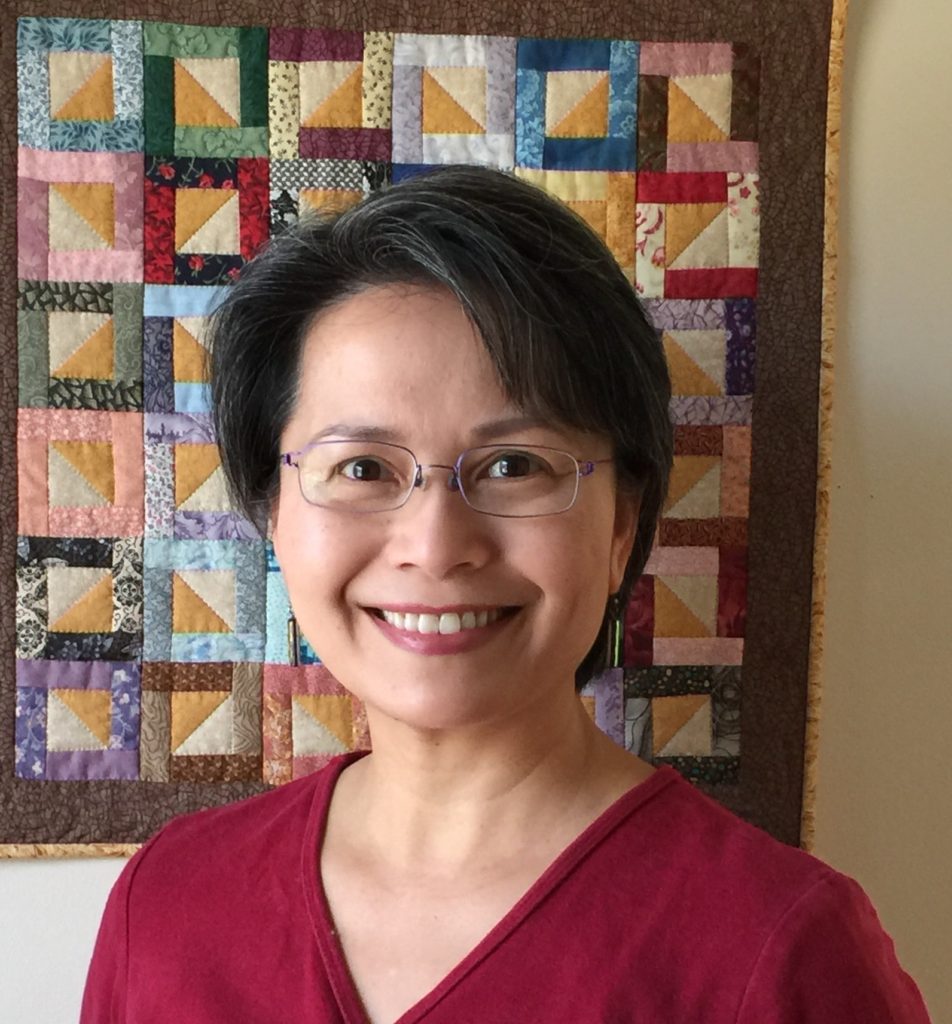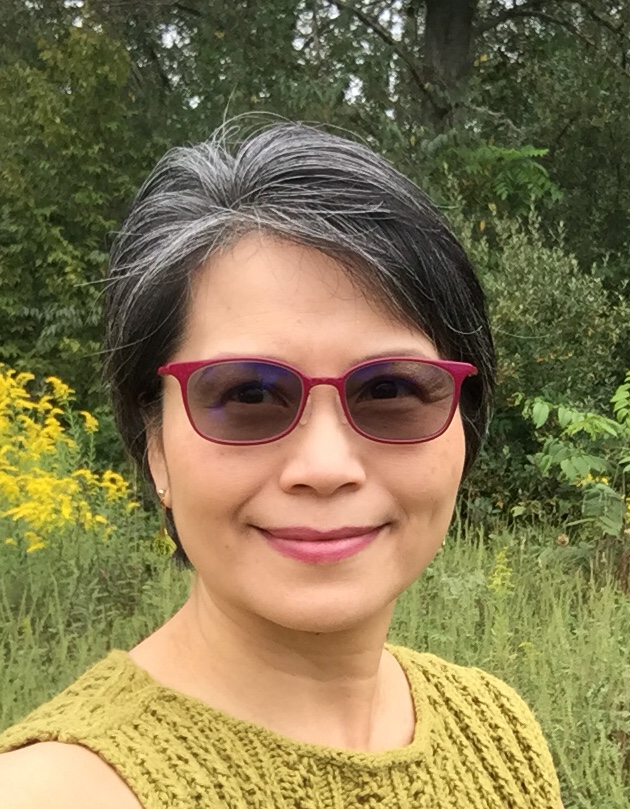Teresa Robeson is the Hong Kong-born, Vancouver-raised, and Indiana-based author of Queen of Physics: How Wu Chien Shiung Helped Unlock the Secrets of the Atom (illustrated by Rebecca Huang), which is the 2020 winner of the APALA Picture Book Award. She is interviewed here by APALA member Molly Higgins.
Molly Higgins (MH): Please introduce yourself and briefly describe your literary work and career path to date.
Teresa Robeson (TR): Thank you, Molly, Dora, and APALA, for featuring me on your blog! It is truly an honor to be recognized by an organization that promotes books by and about Asian/Pacific Americans. My mom would be verklempt were she alive to see this. Our cultural heritage was always of great importance to both my parents.
Because of my own varied interests, I write picture books to adult short stories, with a style that leans more literary than commercial. I tend to focus on nonfiction (biographies, science and nature), speculative fiction, and my own cultural background. Queen of Physics checks two of those boxes!
I started writing for kids back in the early ‘90s after taking a course from the Institute of Children’s Literature (which is now under new ownership). The first story I sent out—an assignment from the course—was published by Ladybug Magazine. And it was based on my own kindergarten graduation in Hong Kong! I continued getting bylines in magazines because I didn’t think I had a whole book in me.
But in 2010, when the kids were old enough to not need me very much, I dove back into writing in earnest, this time with the intent of writing books. I’d honed my writing skills with penning short stories and poetry for a number of years. I felt ready.
MH: Your book, Queen of Physics: How Wu Chien Shiung Helped Unlock the Secrets of the Atom received the APALA Picture Book Award. Can you tell us more about your inspiration for the book?
TR: As I mentioned, my passion is for science and my own culture. So when I saw an article about Wu Chien Shiung, a Chinese American scientist, I just knew I had to write about her! After all, how often do you come across someone who shares your own immigrant status and love of physics? How did I not know about her sooner? She would be such an inspiration to girls who, like me, dream of going into science.
I’ve been asked before where I first learned about Wu, but I don’t have the answer to that. I imagine it was in Physics Today magazine around 2011, which my husband had a subscription to, but I can’t remember for sure.
MH: You discuss discrimination in the book, including the opportunities that Wu lost because she was a woman and because she was Asian. How do you choose the language and level of detail to broach such topics with young readers?
TR: I’m a firm believer that kids are more perceptive than some adults give them credit for. Because of that, I’ve never talked down to kids. Still, I keep in mind the vocabulary level of the intended audience and the necessary background knowledge required to understand certain things. For explaining what Wu had to face, I think all kids understand the feelings of not being chosen, or picked as the winner, for something, whatever the reasons may be. I couched the language to call on their empathy, but didn’t go into too much more detail because a picture book can only be so long.
MH: You participated in the We Need Diverse Books Mentorship Program. Can you tell us how that experience affected your manuscript and publishing process?
TR: The We Need Diverse Books mentorship was a turning point in my career! I almost didn’t apply because I was sure I wouldn’t get it, but my critique partners urged me to. Everyone needs encouraging critique partners.
To my surprise and delight, the incomparable Jane Yolen chose my story to work with! Jane is an amazing mentor: she makes insightful suggestions where needed, prods you to think of solutions, and helps you to consider options you might never have on your own.
With Jane’s expert guidance in 2017, I completely rewrote and polished the manuscript (which I’d been working on since 2012), and started submitting it. I am indebted to her and WNDB for the amazing opportunity.
MH: Who or what influenced you to be a writer?
TR: I have been wrapped in stories as far back as I can remember. Before I could read, I watched many Chinese and Japanese movies and miniseries and ran those narratives in my head when the television was turned off. After I learned to read, I devoured Chinese comics and graphic novels, and every issue of 兒童樂園 (Children’s Paradise). My brain was constantly reliving stories, so it’s not surprising that I felt the need to write some of it down.
My mom was definitely the person who encouraged me to be a writer. But Jo March of Little Women influenced me, too. I read Little Women in fourth grade, a year after we immigrated to Canada and I learned English. It was the first novel I’d read in my new language, and I was enthralled.
MH: We’re always looking for more to read. Who are five authors we should be reading? Why?
TR: Oh, it’s so hard to narrow it down to five! Some POC authors I recommend are Christina Soontornvat, Richard Ho, and N.K. Jemisin. Two non-POC authors whose writing I love are Jessie Sima and Kimberly Brubaker Bradley. Why do I recommend them? It all comes down to voice and perfect, beautiful writing.
If I can throw in two more for a bonus, I’d add Octavia Butler and Connie Willis!
MH: You’re being interviewed by a librarian, for an audience of progressive Asian American librarians. What are your thoughts on libraries and their place in building diverse communities?
TR: I love libraries (and librarians) so much! I still remember getting my first library card after we moved to Vancouver. I was in fourth grade, and it was from the Strathcona Community Library. Strathcona is located near Chinatown and served many of the first-generation immigrants who live in that area. But there were plenty of other non-Chinese who frequented that location so there was a nice mix of people who intermingled among the shelves.
Even in areas not as naturally diverse as Vancouver, the range of a library’s offerings—books, programming, etc. (all free!)—will naturally attract people of all walks of life, income, and culture. Under the roof of my county’s library, I’ve seen white and Black school kids sitting near older Asian folks, and a homeless woman, who uses the bathroom there, brushing past a 7th Circuit Court judge (I know because he’s my neighbor).
Libraries are as close to a microcosm of a perfect society as we can get, a social leveler.

MH: On your website, I see that you offer critiques and consultations to other writers. Do these ever influence your own writing? Is there a piece of advice that you would like to offer to aspiring writers, especially those interested in diverse children’s literature?
TR: I think that earlier in my career, I might have been more influenced by other people’s writing. But I’ve been doing this long enough that I’m aware of my own voice and am resistant to other people’s styles. I’m part of four critique groups and look at stories from 17 people with very different ways of writing. They are each distinct from each other and from me.
That said, when I read a book that is gorgeously written, I find myself mimicking the voice for a little bit. It’s kind of like when I spent 1.5 weeks in London once, I started to talk with a slight British accent without meaning to.
I’d suggest to aspiring writers to read voraciously. Ask your friendly neighborhood librarian for recommendations and read a wide range of genres, but especially those in the genre you write. You’ll start to see how the authorial voices manifest themselves and that will help you find your own.
Another piece of advice is to be in critique groups…at least one. Mine aren’t as diverse as they could be, but I have a friend who started an Own Voices critique group which has worked out very well. Critique groups are very helpful both for having people give you feedback on your work as well as for you to hone your critical eye. By dissecting other people’s writing, you begin to understand what works and what doesn’t and can apply it to your own.
One last piece of advice is to be a part of, and support, initiatives like We Need Diverse Books or Multicultural Children’s Book Day. You’ll find like-minded people to hang out with and also opportunities like mentorships to partake of to improve your writing.
MH: Congratulations on your newest book, Two Bicycles in Beijing! What’s next for you? Are there any other woman scientists that you want to write about next? (Of course, we know there’s some info that you’re not allowed to share!)
TR: Thank you! I want to write about so many other women (and some men) scientists! But I’ve been told that the picture book biography market is saturated, and few people want to publish books on obscure scientists. It’s a vicious cycle: people don’t want to publish books on scientists the public haven’t heard of, but the public will not learn about these scientists if we don’t publish books about them.
My current work-in-progress is a middle grade biography of an amazing woman who rivals Da Vinci in her multitude of talents. I’m a little stuck on how to sell her as someone of a single achievement as I’ve been advised to do. Polymaths are not revered in today’s climate of hyper-specialization and buzz-phrases.
My exciting news that I mentioned during the APALA Virtual Award Ceremony is still not yet public, though I can share that it involves biographies of two people I feel great connections to. I hope to see the announcement soon, but the publishing world works in slow and mysterious ways.
Thank you again for inviting me to the APALA blog! I can be found on the web at a number of places:
Website: teresarobeson.com
Twitter: @TeresaRobeson
Facebook: https://www.facebook.com/TeresaRobesonAuthor/
Instagram: @tmrobeson
Editing assistance by Amanda M. Cheung.

